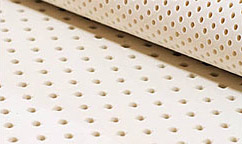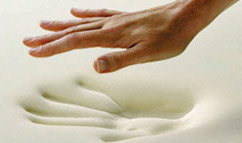
 When you think of the word "home," chances are that your bedroom is the first room that comes to mind. Your bedroom is your refuge: a place to dream, a place to rest, and a place to retreat when the outside world becomes too stressful.
When you think of the word "home," chances are that your bedroom is the first room that comes to mind. Your bedroom is your refuge: a place to dream, a place to rest, and a place to retreat when the outside world becomes too stressful.
Shop our Mattress Selection »

Naturally, you want that room to be as safe and healthy as possible. However, many common products, such as paints and carpets, can emit harmful fumes called Volatile Organic Compounds (VOC's). VOC's are a class of chemicals that includes substances like toluene, formaldehyde and benzene.
According to the EPA, these chemicals show up indoors at relatively high concentrations, approximately 2 to 5 times higher than the amounts present in outside air1. In the short term, they can cause health problems like allergies and asthma. Chronic exposure may increase your risk of cancer and could damage your liver, kidneys and nervous system2. These chemicals are not good for the environment, either. If you are concerned about the health of our planet, you should also be concerned about the health of your bedroom. A green bedroom is healthier for you and healthier for the Earth. This article will show you how to build one from the ground up.
First, take a look at the floor underneath your feet. Is it carpet? Everyone loves the soft feeling of carpet on bare feet, but did you know that indoor carpeting is one of the most common sources of VOC's?3 Also, the chemicals used to manufacture carpets in carpet mills can pollute streams, rivers and groundwater. For example, perfluorooctanoic acid, a likely carcinogen used to manufacture stain-resistant carpets, has been found at high concentrations in the Conasauga River in Georgia, just downstream from the Dalton carpet mills4. Chemicals like these can build up in the bodies of people and animals that live near the mills. Some of these chemicals are so persistent and travel so easily that they can also pollute areas hundreds of thousands of miles away. Perfluorooctanoic acid has been found inside the bodies of polar bears, in spite of the fact that there are no carpet mills in the Arctic.
What's the solution? Instead of choosing synthetic carpet, choose a natural flooring option such as bamboo. As long as it's kept from becoming invasive, bamboo is an ideal earth-friendly material. It's renewable, grows quickly and requires very little chemical "support" to grow. Reclaimed hardwood is another excellent choice for flooring. New wood floors can be "green," too, if the forest is managed sustainably. Look for the "Forest Stewardship Council" seal of approval. Some types of finishes and laminates used on wood floors can emit harmful chemicals into the air. Remember to look for floor materials labeled no or low-VOC. If you want something soft on your feet, look for untreated, organic wool carpeting and rugs. Area rugs made out of hemp or from recycled fabric are also good choices. Hemp, marijuana's non-psychoactive twin, is considered to be an environmentally friendly material because it requires very little water, herbicide or pesticide.
Moving on to the walls, paint is another common source of indoor air pollution. Petroleum-based paints can emit VOC's for years after they dry. Fortunately, there are paints available that emit fewer or no chemicals. These paints also have the advantage of being less hazardous to work with and dispose of. Look for natural latex paints labeled low or no-VOC, paints made from milk protein or even paints made from pigments mixed with clay. If you'd prefer wallpaper, look for wallpaper made from natural materials, such as grass cloth or organic cotton. Another good choice is barkskin, a type of textured wallpaper made of organic bark material. If you are buying wood-pulp wallpaper, look for the Forest Stewardship Council Seal of approval. Don't forget to use a natural adhesive, too. You can either buy natural wallpaper paste or make your own from white flour, water and alum.
Now that you have the walls and the floor taken care of, what about the bed itself? Conventional mattresses are often manufactured using chemicals such as antimony, formaldehyde, and toluene. These chemicals are usually used to give the mattresses better fire resistance or better stain resistance, but at what cost? Part of the problem is that nobody knows for sure. As the Washington Post reports, “of the nearly 80,000 chemicals regularly bought and sold today, according to the National Academy of Sciences, fewer than 10 percent have been tested for their capacity to cause cancer or do other damage."5 This does not mean that your conventional mattress is poisoning you, only that nobody is sure what the long-term effects of small exposures to these chemicals really are. According to National Geographic's Green Guide, off-gassing from synthetic mattresses can be minimized by vacuuming often, keeping the room well-ventilated, and using a HEPA air Filter.6 However, there are mattresses on the market today made from natural materials that don’t off-gas VOC’s. Also, many synthetic mattresses are made out of petroleum-based chemicals, so finding non-petroleum-based alternatives helps preserve our natural resources and reduces the carbon footprint of the mattress.
 Fortunately, avoiding synthetic mattresses does not mean a return to sleeping on mattresses stuffed with straw or corn husks. Today, there are much more comfortable natural alternatives available. The gold standard for a natural good night's sleep is a latex mattress. Latex is a natural substance that is made from the sap of the rubber tree. It can be used to a produce a mattress that is supportive, yet supremely comfortable. In fact, the feel of a latex mattress is often said to resemble that of memory foam. Latex mattresses distribute your weight correctly to keep uncomfortable pressure points from developing. They can be manufactured using two different methods: the older Dunlop process and the Talalay process. The Talalay process usually produces a softer mattress. However, it is more expensive than the Dunlop process.
Fortunately, avoiding synthetic mattresses does not mean a return to sleeping on mattresses stuffed with straw or corn husks. Today, there are much more comfortable natural alternatives available. The gold standard for a natural good night's sleep is a latex mattress. Latex is a natural substance that is made from the sap of the rubber tree. It can be used to a produce a mattress that is supportive, yet supremely comfortable. In fact, the feel of a latex mattress is often said to resemble that of memory foam. Latex mattresses distribute your weight correctly to keep uncomfortable pressure points from developing. They can be manufactured using two different methods: the older Dunlop process and the Talalay process. The Talalay process usually produces a softer mattress. However, it is more expensive than the Dunlop process.
One other environmental advantage of natural latex is that the act of harvesting it does not kill the tree. After the rubber tree is tapped, it keeps growing. As it grows, it removes carbon dioxide from our atmosphere. This also means that latex can be sustainably harvested from the rainforest. In Brazil, rubber tappers have lived in the rainforest for generations. They have been one of the main groups trying to preserve the forest along with their way of life. Chico Mendes, one of Brazil's pioneering activists for sustainable rainforest development, was a rubber tapper.7 Depending on where it comes from, buying natural latex may provide an economic incentive for preserving the rainforest. However, latex can also be manufactured synthetically. Most mattresses being produced today use a blend of natural and synthetic latex. Look for mattresses that are made from a high proportion of natural latex.
 To create a match made in heaven, top your new latex mattress off with one of the new soy-based memory foam mattress toppers (available in complete mattress sets as well). Although they do contain synthetic chemicals, soy-based memory foam replaces some of the petroleum used in the original recipe with a product made from soybean oil. This results in a finished product with a much lower carbon footprint. For example, memory foam products made from soybean oil require 61 percent less non-renewable energy to manufacture, and produce 36 percent fewer greenhouse gas emissions.8 You can find both memory foam mattress toppers and entire memory foam mattresses that are made from soy. Since they feel exactly like regular memory foam, these products are a great way to help the environment and sleep in comfort at the same time.
To create a match made in heaven, top your new latex mattress off with one of the new soy-based memory foam mattress toppers (available in complete mattress sets as well). Although they do contain synthetic chemicals, soy-based memory foam replaces some of the petroleum used in the original recipe with a product made from soybean oil. This results in a finished product with a much lower carbon footprint. For example, memory foam products made from soybean oil require 61 percent less non-renewable energy to manufacture, and produce 36 percent fewer greenhouse gas emissions.8 You can find both memory foam mattress toppers and entire memory foam mattresses that are made from soy. Since they feel exactly like regular memory foam, these products are a great way to help the environment and sleep in comfort at the same time.
Now that you've chosen the mattress, what should you put on top of it? Sheets and bed linens are often made from conventionally grown cotton. Worldwide in 2003, 55 million pounds of pesticide were used to grow conventional cotton.9 That's approximately 4.3 pounds of pesticide per acre! These chemicals often escape from the cotton fields and poison groundwater. Pesticides can also harm the farm workers hired to pick the cotton. Instead of conventionally-grown cotton, choose organic cotton sheets and quilts, or choose sumptuous fabrics made from bamboo or hemp. Quilts made from recycled clothing are another interesting and unique decorating choice.
No bed is complete without lots of fluffy pillows. Look for pillows covered in organic cotton or bamboo. Also, check the label to see what the pillow is stuffed with. Most pillows are filled with either down or polyester stuffing. Down is extremely comfortable and a renewable resource. This makes it a much greener choice than polyester. You can also try pillows filled with buckwheat instead. Buckwheat is very comfortable, conforms to the contours of your head and neck and deters dust mites.10 Pillows with polyester stuffing can be eco-friendly, too, as long as the fill is made of recycled materials such as plastic soda bottles.
Now that you've got the cozy, comfortable, eco-friendly bed of your dreams, what about the other furniture in your bedroom? Most of the furniture on the market today is made at least partly of particleboard. As a building material, particleboard sounds eco-friendly enough at first. After all, it's made of recycled wood and sawdust that would otherwise be thrown away. The problem with particleboard arises when these wood chips are glued together. Most manufacturers use urea formaldehyde resins, which produce formaldehyde emissions of around .2 parts per million from the finished furniture. Health experts recommend a level of exposure of to formaldehyde of .1 parts per billion or lower.11 Instead of particleboard, look for solid wood furniture that's either used or made from reclaimed wood. Some particleboard furniture is also made using phenol formaldehyde resin, a different type of adhesive that emits much less formaldehyde.
Another important part of going green is conserving energy wherever possible. If you like to cuddle up under lots of blankets in a cool room when you sleep, use a ceiling fan instead of cranking up the AC. Put blinds and curtains on your windows and use them strategically. Open the curtains to let the warm sunlight in on cold days and close them to keep the room cool on hot days. Also, use energy-efficient lighting. Whenever possible, that means harnessing and magnifying natural sunlight. Again, use your windows strategically to let light in, and place mirrors where they can reflect light back into rest of the room. Don't forget to caulk around the windows to seal up cracks! By using less energy, you’ll lower your carbon footprint and pay less in utility bills.
When you have to turn on a light, select LED's or compact fluorescent bulbs to save energy. Everyone wants soft lighting for the bedroom, not the harsh white light you get from older CFLs. However, the newer CFLs can produce warm, natural light just like incandescent bulbs. You just have to know what to look for on the package. To make sure you are getting the right amount of brightness, check to see how many lumens the bulb produces. An 870-lumen fluorescent bulb will give you the same amount of brightness as a 60-watt incandescent. For a warmer color, look for bulbs with a lower temperature ratings, around 2,700 to 5,000 Kelvin. Although red light has a "warmer" color than blue light, it is actually lower on the spectrum and therefore has a lower temperature. Finally, look for a bulb with a high color rendering index (CFI). The coloring rendering index measures the ability of the bulb to illuminate colors in a natural way. Natural daylight has a CFI of 100, but anything over 80 is good.
If you can't afford to make your bedroom completely green right now, that's fine. Most people have limited resources, so going green is something that often has to be done one thing at a time. If you can't afford to get new flooring right now but you desperately need a new mattress, just focus on choosing a green mattress. The most important thing is that you keep these "green" guidelines in mind whenever you need to replace something in your bedroom or when you decide it’s time to remodel.
1 http://www.epa.gov/iaq/voc.html
2 http://www.health.state.mn.us/divs/eh/indoorair/voc/
3 http://www.health.state.mn.us/divs/eh/indoorair/voc/
4 http://www.timesfreepress.com/news/2008/feb/10/epa-finds-high-levels-stain-resistance-ingredient
5 http://www.thecabin.net/stories/110607/opi_1106070013.shtml
6 http://www.thegreenguide.com/doc/ask/mattress
7 http://en.wikipedia.org/wiki/Chico_Mendes
8 http://www.chron.com/disp/story.mpl/life/homegarden/5005594.html
9 http://www.motherearthnews.com/Nature-Community/Organic-Cotton-Benefits.aspx
10 http://www.summasleep.com/productinfo.html
11 http://pqasb.pqarchiver.com/washingtonpost/...




 Copyright © 2024 |
Copyright © 2024 |